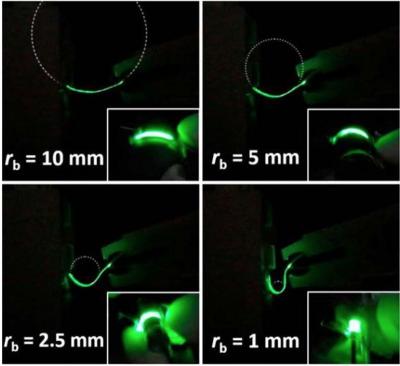Researchers from the Ulsan National Institute of Science and Technology (UNIST) have developed perovskite LEDs (PeLED) which are flexible enough to be folded. A transparent material was used in the electrode of the device as a replacement for metal to ensure translucency.
 Flexible translucent PeLED maintains performance even when bending curvature is small
Flexible translucent PeLED maintains performance even when bending curvature is small
According to the team, PeLED is a kind of light emitting diode (LED) that emits light by injecting current into a compound. This device uses a perovskite material as an active layer that emits light by receiving electricity, and its advantages include high electron mobility, good color purity, and easy color control. However, conventional PeLEDs are low in flexibility and opaque due to limitations of metal electrodes.
This study also received attention as a technique that can measure the mechanical properties of PeLED. The mechanical properties were analyzed by lightly grabbing or pressing the constituent materials produced by the same method as the PeLED manufacturing process. It is evaluated as a more accurate technique than the conventional method, which measures flexibility through changes in the efficiency by repeatedly bending the entire PeLED device.
"The new measurement technique enables evaluation of the flexibility of the device using the elastic limitation of the PeLED constituent materials, leading to a more accurate analysis of the cause of the degradation of the device," said Dr. Kim Si-hoon, the co-first author of the paper. 'In addition to PeLED, the technique can also be used for multi-layered flexible devices."
Perovskite materials readily react with moisture or oxygen in the air, which degrades performance. For this reason, it is known to be difficult to measure the mechanical properties of a thin film type perovskite used in actual devices. On the other hand, in this study, the research team succeeded in measuring the mechanical properties of the thickness, which is used as a component of an actual device, by using an electron microscope that operates in a vacuum state.

